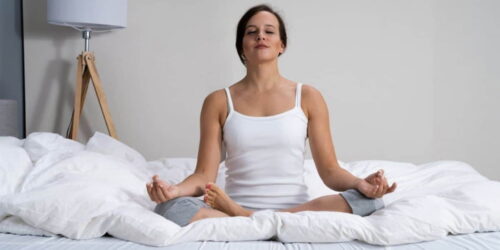Can You Meditate With Your Eyes Open and How?
There is no right or wrong response to this query; everyone will have their own preferences. While some people find it easier to concentrate with their eyes closed, others prefer to do so. It might be a good idea to try both methods of meditation if you’re new to it to determine which one suits you better.
There are many ways to meditate, but most experts agree that it works best if you can close your eyes. Why? Because practicing meditation can be an internal process where you learn to pay attention to your inner thoughts and feelings in a nonjudgmental manner. Before discussing whether it’s possible to meditate while keeping your eyes open, let’s quickly review what meditation entails.
Table of Contents
What is Meditation?
Meditation is the practice of deliberately and non-judgmentally focusing your attention on one thing at a time. This can take many different forms, such as focusing on your breath during meditation, your body’s sensations, the sights and sounds around you, or a mantra (i.e., words repeated silently).
Read about
Why Do People Believe Meditation Requires Closed Eyes?
- When we’re not in meditation, our minds are frequently fixed on internal thoughts.
- It is more difficult to engage in inward meditation because sensory organs like the eyes and ears keep us bound to our physical senses.
- Many instructors advise closing your eyes to reduce potential interruptions because opening them exposes you to them.
Although having open eyes during meditation may seem contrary to the standard practice, it is actually more common.
Many Traditions Use Open-eye Meditation
- Tibetan Buddhism: The traditional posture for meditation is to look down, with our eyes at a 45-degree angle. The mind’s ability to create images and engage in other distracting activities is limited by open eyes.
- Zen Buddhism: focuses on engaging and being present in the world (the bodhisattva ideal) rather than escaping and isolating yourself from the world with closed eyes.
- Trataka Meditation: The third eye is opened during a Hindu and yoga meditation that involves staring at a candle flame.
In Tibet and Japan, the majority of Buddhist traditions never close their eyes. They advise you to relax, look down, and half-close one eye. However, teachers advise closing your eyes because trying to keep them open or blinking frequently can cause confusion in beginning meditators.
What Happens When You Meditate With Your Eyes Open?
Some people think it’s impossible to meditate while keeping your eyes open because doing so can interfere with your ability to focus. Others, on the other hand, discover that keeping their eyes open enables them to more fully engage with their surroundings and keep their attention on their breath or mantra.
Both strategies have advantages and disadvantages. People who choose to keep their eyes open may find it simpler to stay aware of their surroundings, while people who choose to keep their eyes closed may find it easier to concentrate on their internal experience.
It is ultimately up to the person to choose what suits them the best. While some people are able to do both, others would rather stick to one or the other.
Read about Can You Meditate With Music?
Pros of Open-Eye Meditation
Every day, your mind processes countless thoughts.
It is simple to understand why people are so stressed out when you consider this along with the conscious demands and expectations made of you every single day.
In fact, this is the main reason so many people start practicing meditation. They are searching for a sense of calmness and peace.
Unfortunately, a lot of people have a tendency to stop practicing meditation.
Some of them insist that finding peace is too difficult and that the environment is not conducive to meditation. But when it comes down to it, this is when meditation is most important.
You can’t do traditional meditation anywhere at any time, which is perhaps one of its drawbacks. It requires you to close your eyes.
The only way you can do it wherever you want is if you want to accidentally fall asleep at work while you’re meditating. Trying to stay awake while practicing eye-closed meditation in order to prevent dozing off is another difficult task.
That being said, not everyone may benefit from closed-eye meditation. So whatever the case may be, open eye meditation is a valuable option, and here’s a few reasons why:
Easy to Learn
If you have previously meditated, this will undoubtedly be a piece of cake for you since all you need to do is switch from closing your eyes to opening them during meditation.
Can Be Done Anywhere
Because your eyes are opened, you can meditate anywhere and at any time.
Because your eyes are open, you can meditate whether you’re standing in a busy street or sitting in a quiet room.
Gives You More Clarity
Many people struggle to focus while meditating with their eyes closed. This is so that when you meditate with your eyes open, you are forced to concentrate on a single point, whereas closing your eyes allows your mind to wander.
Furthermore, focusing on a visual feature or object is easier for the mind to do when something is present than when it is not. Thus, open eye meditation can aid in improving your ability to concentrate.
Switching Between Closed Eye and Open Eye Meditation
You’re probably wondering if you can alternate between closed-eye and open-eye meditation. In the end, you should pay attention to what your mind requires at any given moment.
Since there is no one right way to meditate, the best practice is the one that yields the best results for you.
If you feel that closed eye meditation works better for you, then go with it, and if you feel that open eye meditation is best, stick with that.
But open eye meditation is advised if, like many others, you would like to carry your practice with you wherever you go.
This is not to say that one meditation technique may be better than the other, but both have advantages over the other, so you should choose whichever you prefer.
Consistency is a key concept to keep in mind. Regardless of whether you use closed or open eye meditation, in order to be truly successful, you need to pick a technique that complements your personality and lifestyle so that you can consistently practice it.
Read about Can You Meditate Lying Down?
Ways to Make Practicing Open-eye Meditation Easier
- Half-open-eyes: According to custom, it will help limit visual distractions and lessen eye fatigue if you close your eyes and place them 4 feet in front of you.
- Face a blank wall: By meditating with open eyes while facing a blank wall, the Zazen technique reduces interruptions. Avoid staring off into the distance where numerous objects might divert your attention.
- Darken the room: lessens distraction, but may cause sleepiness.
- Pick a single point of focus: Choose a simple activity that you can lose yourself in, and keep in mind that you shouldn’t strain your eyes to focus on it. Instead, keep your gaze fixed on the object at hand and avoid looking elsewhere.
- Use a candle: Without passing judgment, bring your attention to one particular area of the candle flame and rest your eyes there.
- Watch a spinning fan: You can lose yourself in the rhythm if you keep your attention on something that is constantly moving. Additionally, it will clarify the distinction between focusing your gaze and your eyes. Simply avoid letting the fan blow air into your eyes.
- Walk around slowly: In the traditional Zen meditation (Zazen), you sit with your eyes open and then slowly walk in a small circle. Start by paying attention to the feelings in your feet as they make contact with the ground. Then pay attention to your legs and other moving body parts.
- Practice throughout the day: The beauty of open-eye meditation is that you can practice it whenever, whether you’re working out, doing the dishes, or just getting around the house. and is only possible for a short period of time at a time.
- Don’t switch from open to closed eyes in a single session: Your restlessness will divert your attention and prevent you from developing focus. except that as you deepen your meditation, your eyes will naturally close. Alternatively, if you start to nod off, open your eyes.
Without getting sidetracked by thoughts or other distractions, we want the open-eyed presence of meditation. So, whenever your mind wanders, just remember to bring it back. And make an effort to focus only on things that are straightforward and simple.
Should You Meditate With Closed Eyes?
- It is simpler to concentrate on internal feelings when your eyes are closed, but falling asleep is also made simpler.
- Your consciousness is more engaged with the physical world when your eyes are open, but there are also more distractions.
Open-eye meditation is not inferior, so don’t hold yourself back from trying it. Both have a place in your meditation journey and practice, so that is untrue. Follow your gut and what feels right to you.
How to You Visualize With Your Eyes Open?
- When you consider your objectives or aspirations, look at a picture that holds a special meaning for you.
A sandy beach might stand in for a trip to Bali, for example, if you want to manifest this. Or, if you want to lose weight and gain muscle, a stunning fitness model might be the solution. It could be a drawing, a photo, or even an image on your computer or smartphone.
- Your eyes should be relaxed, your eyelids should be relaxed, and you should look slightly downward with your eyes either half- or fully open. Choose a relaxing activity for yourself.
- Just as you would when daydreaming, start visualizing your ambition or goal.
Keep glancing at your photo. Create a story based on this image and your objective to start.
If you’ve done it a few times, try looking at the picture, drawing, or image only at the beginning of your session, and then, from step 2 on, look at a blank wall or into the distance (the lake, skyline, forest, or ocean).
Related Questions
Is Open Eye Meditation Better Than Closed-eye Meditation?
No one is not more superior to the other and both have benefits to offer.
Can You Switch Between Open and Closed Eye Meditation?
Absolutely, you can.
Is Open Eye Meditation Easier?
Because you can picture an actual object, many people find it to be simpler. It’s also more practical because you can do it anywhere.
In Closing
I hope you enjoy it and benefit from it as much as I have. Even though I don’t always meditate while keeping my eyes open, there are times when it’s just what I need. Having different meditation techniques in your meditation toolbox can help you stick with your practice through the natural ebb and flow of your life. When you believe you aren’t making any progress, it can help you keep going. Or perhaps your experience with a technique you’ve been using for some time suddenly changes and, for whatever reason, doesn’t feel like a good fit right now.
In the comments section below, kindly share your opinions with me. Have you ever attempted to practice open-eye meditation? How has it worked out for you?
I hope your meditation journey is fruitful. I hope it brings you happiness, peace, and a spring in your step. Namaste.





